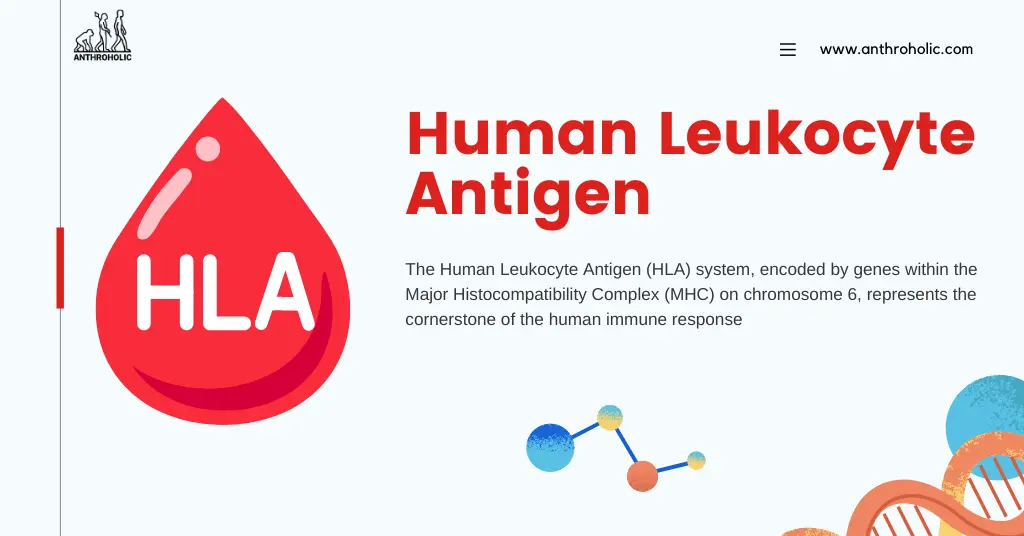AI Answer Evaluation Platform Live Now. Try Free Answer Evaluation Now
Human Leukocyte Antigen
The Human Leukocyte Antigen (HLA) system, encoded by genes within the Major Histocompatibility Complex (MHC) on chromosome 6, represents the cornerstone of the human immune response [1]. It’s of immense significance in anthropological research, as it provides insights into human evolution, migration, and adaptation patterns. Understanding the HLA system can offer crucial clues about our ancestors, their migratory routes, and how they adapted to changing environments.

The HLA System
The HLA system consists of various genes responsible for encoding MHC class I and II proteins. These proteins play a pivotal role in antigen presentation to immune cells, thereby controlling the human immune response.
There are three main HLA class I genes—A, B, and C—and three principal HLA class II genes—DR, DQ, and DP. Each gene has multiple allelic variations, and these variations lead to a vast diversity of HLA alleles globally.
| Class I | Class II |
|---|---|
| HLA-A | HLA-DR |
| HLA-B | HLA-DQ |
| HLA-C | HLA-DP |
HLA in Human Evolution and Migration
HLA polymorphisms and their geographic distribution provide a window into human evolutionary history. Various studies reveal how selective pressures, such as diseases and local environmental conditions, have driven HLA diversity [2].
HLA and Disease Resistance
One of the most fascinating aspects of the HLA system is its role in disease resistance. Distinct HLA alleles confer resistance to specific diseases, a factor that might have driven the selection of these alleles in certain populations. For instance:
- HLA-B53 provides protection against severe malaria, and is found in high frequencies in sub-Saharan African populations where malaria is endemic [3].
- HLA-B27 is linked to a lower susceptibility to HIV-1, but it is also associated with autoimmune disorders such as ankylosing spondylitis [4].
HLA and Reproductive Fitness
HLA’s role in mate selection and reproductive success is another interesting area of study. Research indicates that women prefer men with different HLA alleles, possibly to increase offspring’s immunological robustness [5].
HLA and Disease Susceptibility
Beyond disease resistance, the HLA system is also implicated in susceptibility to several diseases, especially autoimmune conditions. For example:
- HLA-DR4 is associated with an increased risk of developing Rheumatoid Arthritis.
- HLA-DQ2 and DQ8 confer a higher susceptibility to Celiac Disease.
Given the unique distribution of HLA alleles among different populations, anthropological studies provide vital information on the geographical distribution of these diseases.
Population Genetics and HLA
The tremendous diversity of HLA alleles across human populations can be leveraged to understand genetic relatedness and diversity among different ethnic groups. HLA typing has been utilized to determine the genetic distance between populations, establishing kinship and migration patterns.
HLA in Anthropological Genomics
Using HLA allele frequency data, anthropologists can trace migratory routes and detect intermingling of populations. This has been applied in numerous studies:
- The Aleuts of Alaska show a unique combination of HLA alleles, reflecting their isolated evolution and minimal genetic admixture with other populations.
- Indigenous Taiwanese populations exhibit distinct HLA patterns, echoing their Austronesian roots and shedding light on the peopling of the Pacific.
The Future of HLA in Anthropological Research
The role of the HLA system in anthropological research is likely to expand further with advancements in technology. Genomic studies can be augmented with phenotypic data and epidemiological studies to provide a holistic understanding of human evolution and adaptation. These studies will continue to shed light on:
- Pathogen-driven evolution
- Reproductive fitness and mate selection
- Genetic adaptations to local environmental conditions
Conclusion
The HLA system serves as a comprehensive evolutionary archive, making it an essential tool in anthropological research. It helps illuminate the paths traversed by our ancestors, their adaptations to varying environments, and the ongoing interaction between genetics and disease. As we continue to decode the secrets held within HLA, we will undoubtedly glean more insights into the story of our shared human heritage.
References
[1] Felix, J. P., Reginaldo, L. P. S., & van Rood, J. J. (2016). The HLA System: Genetics, Immunology, Clinical Testing, and Clinical Implications. Yonsei Med J, 57(1), 2–10.
[2] Prugnolle, F., Manica, A., Balloux, F., et al. (2005). Geography predicts neutral genetic diversity of human populations. Curr Biol, 15(5), R159–R160.
[3] Hill, A. V., Allsopp, C. E., Kwiatkowski, D., et al. (1991). Common west African HLA antigens are associated with protection from severe malaria. Nature, 352(6336), 595–600.
[4] Balter, M. (2007). The Ties That Bind. Science, 318(5849), 546-549.
[5] Wedekind, C., Seebeck, T., Bettens, F., et al. (1995). MHC-dependent mate preferences in humans. Proc Biol Sci, 260(1359), 245–249.




